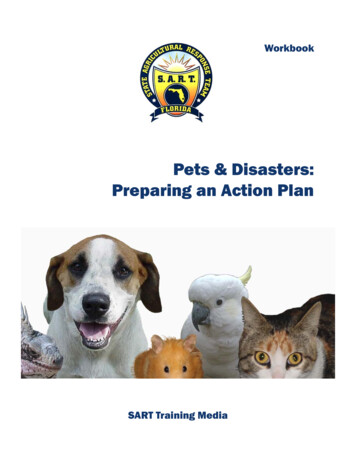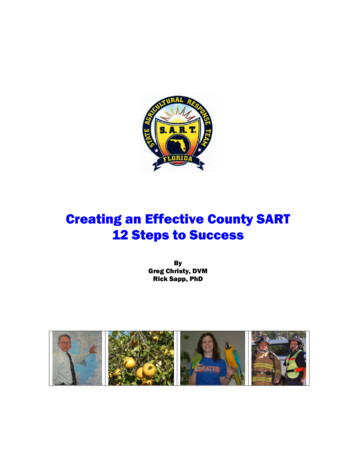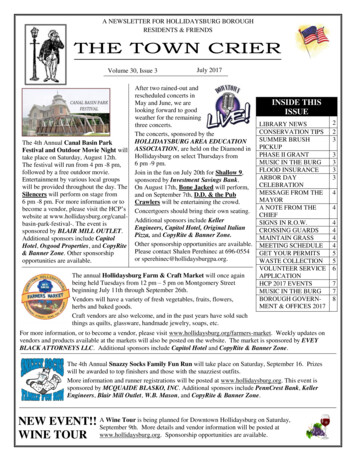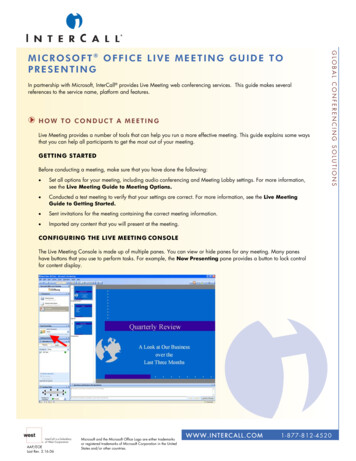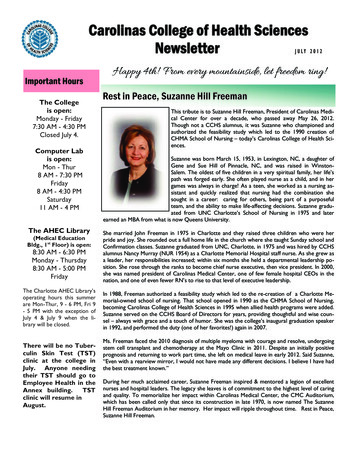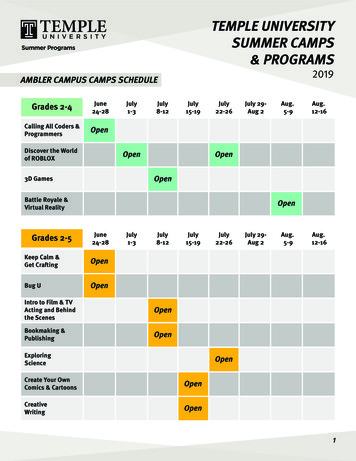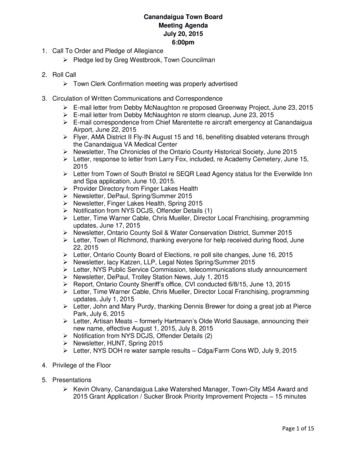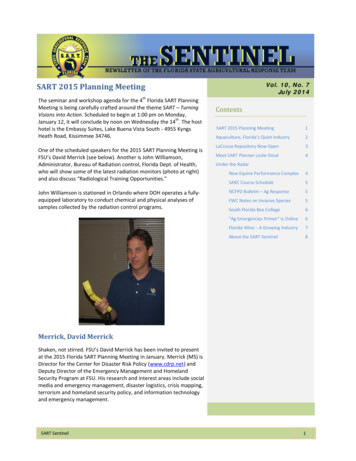
Transcription
Vol. 10, No. 7July 2014SART 2015 Planning MeetingthThe seminar and workshop agenda for the 4 Florida SART PlanningMeeting is being carefully crafted around the theme SART – TurningVisions into Action. Scheduled to begin at 1:00 pm on Monday,thJanuary 12, it will conclude by noon on Wednesday the 14 . The hosthotel is the Embassy Suites, Lake Buena Vista South - 4955 KyngsHeath Road, Kissimmee 34746.One of the scheduled speakers for the 2015 SART Planning Meeting isFSU’s David Merrick (see below). Another is John Williamson,Administrator, Bureau of Radiation control, Florida Dept. of Health,who will show some of the latest radiation monitors (photo at right)and also discuss “Radiological Training Opportunities.”John Williamson is stationed in Orlando where DOH operates a fullyequipped laboratory to conduct chemical and physical analyses ofsamples collected by the radiation control programs.ContentsSART 2015 Planning Meeting1Aquaculture, Florida’s Quiet Industry2LaCrosse Repository Now Open3Meet SART Planner Leslie Stout4Under the RadarNew Equine Performance Complex4SARC Course Schedule5NCFPD Bulletin – Ag Response5FWC Notes on Invasive Species5South Florida Bee College6“Ag Emergencies Primer” is Online6Florida Wine – A Growing Industry7About the SART Sentinel8Merrick, David MerrickShaken, not stirred. FSU’s David Merrick has been invited to presentat the 2015 Florida SART Planning Meeting in January. Merrick (MS) isDirector for the Center for Disaster Risk Policy (www.cdrp.net) andDeputy Director of the Emergency Management and HomelandSecurity Program at FSU. His research and interest areas include socialmedia and emergency management, disaster logistics, crisis mapping,terrorism and homeland security policy, and information technologyand emergency management.SART Sentinel1
Merrick developed, and now oversees, CDRP’s Disaster Incident Research Team(DIRT), which deploys to the field and performs field research on disaster andemergency management in situ. This team consists of staff and students withresearch agendas.David Merrick teaches in the Emergency Management & Homeland SecurityProgram which is part of FSU’s College of Social Sciences and Public Policy.Students in the EMHS Program may select classes covering a range of topics,from the core principles of Emergency Management to related areas in PublicHealth and Terrorism Studies. EMHS courses are also offered online.Merrick currently teaches Foundations of Emergency Management, DisasterSystems and Emergency Management Planning and Policy, and routinely lectureson logistics, technology and cyber security in other EMHS courses. Check out hisblog at staff/david-merrick/merricks-blog/.Florida’s Quiet Industry – AquafarmingAquaculture, simply defined as the cultivation of aquatic organisms, is Florida's most diverse agribusiness, says FDACS.Over 900 aqua-culturists produce the greatest variety of aquatic species of any state in the nation, including aquariumand food fish, mollusks, reptiles, crustaceans, corals and aquatic plants.The USDA has reported U.S. aquaculture sales at 1.5 billion. With 530 Florida farms reporting 71 million in sales,thFlorida ranks 7 of the 47 states reporting. Current production, says the UF/IFAS Tropical Aquaculture Laboratory inRuskin, includes more than 800 varieties of freshwater fish, 200 varieties of freshwater plants, and a growing numberof marine fish, invertebrates, and live rock on about 200 certified farms.Several trade associations support aquaculture in the Sunshine State. Florida Tropical Fish Farms Association(www.ftffa.com), now 50 years old with 172 regular and associate members, notes: In the Tampa Florida area, where the majority of Florida breeding farms are located, a farm can be from 5 to100 acres, utilizing ground ponds due to their rich mineral content and artesian wells. In the winter the pondsare covered with plastic to retain heat.SART Sentinel2
In the Miami Florida area, where there is the second largest concentration of fish farms in the state, a fishbreeding farm is from 1 to 5 acres. Because of the coral rock ground base in the Miami area ground ponds arenot feasible and breeding and growing out is done in above ground concrete vats.With about 70 members, the Florida Aquaculture Association(www.flaa.org) was formed in 1983.Florida has a unique and diverse aquaculture industry whichincludes the culture of tropical ornamental fish, aquatic plants,clams, shrimp, alligators, tilapia, catfish, live rock and otherassorted aquatic animals.In 2003, Florida aquaculture producers reported 95.5 million infarm-gate sales, of which 49.4 percent ( 47.2 million) was thesale of tropical fish, 21.4 percent ( 20.4 million) aquatic plants,and 13.6 percent ( 13 million) clams and oysters (USDA NationalAgricultural Statistics Service 2004).Florida’s “Freeze line” runs roughly SouthwestNortheast across the central peninsula, fromTampa through Orlandoto Daytona Beach.Citrus Repository Opens in LaCrosseA state-of-the-art FDACS facility to improve the health of Florida's endangered citrus industry, the Florida CitrusRepository, has opened in LaCrosse.The Repository will expand the Citrus Germplasm Introduction Program, which provides a way to safely introducehealthy new citrus varieties. New varieties increase the strength of Florida’s endangered citrus industry and allowFlorida citrus to better compete in domestic and international markets.“More than half of Florida’s groves are infected with citrus greening, and citrus production is at a 30-year low,” saidFlorida Commissioner of Agriculture Adam Putnam. “This new facility will help growers replant lost trees and supporta comeback of our signature crop.”SART Sentinel3
The 20,000 sq/ft Repository expects to introduce more than 20 new varieties each year. New varieties will matchgrowers’ and consumers’ preferences for disease-tolerant, easy-to-peel and seedless citrus, following an approvalprocess that includes testing for pests and diseases. New plants are raised under quarantine until they are safe torelease. With the spread of citrus canker and citrus greening statewide, finding new varieties is imperative tomaintaining Florida's 9 billion citrus industry, which directly supports 75,000 jobs.The LaCrosse facility is opening four months after expansion of the state's Dundee Biological Control Laboratory,which is integral to Florida's fight against citrus greening. The Laboratory rears a beneficial insect, Tamarixia radiata,which attacks the Asian citrus psyllid – the vector of citrus greening – for release in Florida citrus groves.New SART Planner is on the jobFollowing SART Planner Stephen Barineau’s departure, ESF-17 ECO Joe Kight of FDACS, DPIsearched for a replacement. Joe is pleased to announce that Leslie Stout has been hired inthat position and is now on the job. She is available for questions about the scheduled2015 Planning Meeting, the Fall SART Advisory Board Meeting (Tuesday, September 16)and other issues pertaining to SART and effective animal and agricultural response inFlorida. Leslie is working on her MA in Urban & Regional Planning at FSU and hopes, oneday in the future, to own a small farm. Welcome Leslie!Under the RadarVet College Opens Equine Sports Performance ComplexThe College of Veterinary Medicine at UF recentlyopened an equine sports performance complex toexamine horses with subtle injuries. The primary goal ofthe complex is to treat horses before their injuriesbecome irreversible. Adjacent to the Vet School’s LargeAnimal Hospital on Southwest 16th Avenue, the arenahas two functions: serve student learning needs and as aresource for horse owners who are seeking medicalattention for their animals.A special feature of the 600,000 performance complexis its two flooring surfaces: part asphalt and part amixture of crumb-rubber and clay-sand developedespecially for horses. The two surfaces are needed toevaluate a potentially injured horse.SART Sentinel4
Florida SARC Schedules CoursesSmall Animal Emergency Sheltering – Awareness LevelThe Florida State Animal Response Coalition is teaching this course to promote effective response for animals duringdisasters. Registration is required, but due to grants from Florida Division of Emergency Management and U.S.Department of Homeland Security, no fee is charged for attendance. This course is certified by FDEM as course codeFL-003-RESP. Date & Time: Sunday, August 10, 8:00 am – 6:00 pmLocation: American Red Cross Capital Area Chapter1115 Easterwood Drive, TallahasseeFlorida SARC Train the Trainer WorkshopIf you have been an assistant trainer or administrative support person at a SARC class or if you have taken the SARCAwareness Level Small Animal Emergency Sheltering course and thought, “I would love to help teach this course,”here is your opportunity, says Florida SARC Director of Training Consie von Gontard.SARC will hold a Train the Trainer class for those who would like to learn to be a Lead Instructor or to assist in teachingthis class. Instructors and trained responders are needed in every region of Florida. [Illustrating the interest in such aclass, registration has filled rapidly. SARC is accepting registration for a standby list.] Date & Time: Saturday, August 9 (9:00 am to 5:00 pm) to Sunday,August 10 (9:00 am to 3:00 pm)Location: Cat Depot, 2542 17th Street, SarasotaFor information and registration go to http://www.flsarc.org/Training.html or contact Melissa Forbergtraining@flsarc.org (352) 658-1224, Pam Burns pamburnssarc@gmail.com, Andy Bass training@flsarc.org or ConsieVon Gontard training@flsarc.org.NCFPD Creates Training FrameworkDr. Kendra Stauffer, DVM, now on station as a Veterinary Medical Officer with the U.S. CDC in Tbilisi, Republic ofGeorgia, recently forwarded a pdf from the U.S. National Center for Food Protection and Defense of DHS. Not longerthan one page, it begins “The United States food and agriculture systems are vulnerable.” It adds, the Center “iscreating a comprehensive training framework for animal agriculture emergency responders.” The pdf is linked here.[Thank you Dr. Stauffer. Be safe.]FWC: Thoughts on Invasive SpeciesWe’ve often discussed Florida’s over-abundance of non-native pests – more than 500 at latest FWC count – althoughone would be too many. The Fish & Wildlife Conservation Commission (FWC) says non-natives can spread rapidly. TheCuban tree frog, for instance, was introduced in 1931 via packing materials. It invaded Florida's natural areas to preyon native tree frogs and, by the ‘70s, was common throughout most of the state.On the other hand, it might take years for factors to fall into place to allow a species to expand its range and causeecological problems. For example, green iguanas have resided in Florida since the ‘60s, only becoming a problem afterHurricane Andrew in 1992. Although green iguanas have not had ecological impacts, this Latin Lizard damageslandscape plants in Miami-Dade and Broward. On the west coast, black spinytail iguanas are now an abundantnuisance.SART Sentinel5
The Green Iguana in Florida – invasive but non-threatening?Invasive’s do not cause problemsequally in all areas. The nutria, a largeSouth American rodent, lives in warm,marshy areas. It’s abundant in thelowlands of Louisiana and Mississippi,but Florida populations have not beenvery successful even though Floridahas similar habitats to other Gulf Coaststates. On the other hand, notes theSentinel editor, Florida is home tomillions of hungry h Florida Bee CollegeThe on-going crisis affecting honey bees – a complex ofproblems lumped under the term “colony collapse disorder” –world-wide has promoted research and education into thepollinator that 7 billion humans cannot live without. UF’s IFASndhas set Friday and Saturday, August 15-16 for its 2 annualSouth Florida Bee College. The event will take place at UF’s Ft.Lauderdale Research and Education Center, 3205 College Ave.,Davie, FL 33314. Registration (attendees must register online) isnow open ee college.shtml.The Honey Bee Research and Extension Lab at UF writes, “the two-day event offers classes forbeekeepers of all ages and experience levels, gardeners, naturalists, county agents and anyone elseinterested in honey bees. You do not have to keep bees to attend; the only prerequisite is yourinterest in the subject! Even if you have attended the UF Bee College before, we are sure that youwill find that the SFBC will be just as fulfilling. The course lineup has topics to suit your practicalneeds as well as satisfy your growing curiosity on a diversity of honey bee related subjects. We have asuggested beginner track lineup for novices, though students at the SFBC may attend any courseregardless of expertise.” Lunch and snacks are included as is a catered banquet no Friday evening.Agriculture Emergencies: A Primer for First RespondersThe article “Agriculture Emergencies: A Primer for First Responders” is available online 339/.Prepared by Johnnie Gilpen, Hélène Carabin, James Regens and Ray Burden it covers much of the ground that FloridaSART responders already understand, but puts the knowledge in a wider context (at least as of June 2009). They write,“In order to properly respond to future agriculture emergencies, emergency response professionals need tounderstand the nature and implications of the event as well as their roles and responsibilities, but the availability ofeducational and training opportunities is limited.“The results of our review are consistent with the hypothesis that more resources, education, and trainingopportunities should be available to responders as well as to producers, importers and shippers, internationalSART Sentinel6
travelers, and the general public. Increased education and training will raise awareness among these groups of therelationship between animal and human health.”Wine from Florida – A Sunshine State Agricultural HighlightDid you know there are currently 24 independently owned Certified Farm Wineries (and 15 additionalnon-certified wineries) registered with FDACS in the state of Florida? In 2012, Florida produced nearly 2million gallons of wine – a significant amount, but tiny compared to California’s output of 668 milliongallons.Many Sunshine State wineries rely on indigenous muscadine vines, hybrid bunch grapes or exotic andcitrus fruit varieties to produce table, sparkling and dessert wines, from dry white and red to sweet andfruity. Most Florida wineries offer wine tasting, interesting winery tours and special events, often with livemusic to enhance a local day trip or weekend visit. http://www.tryfloridawine.com/ The Florida GrapeGrowers Association http://www.fgga.org/ was established in 1923.Unlike many farms and dairies, Florida wineries generally encourage visitors:SART Sentinel7
About the SART SentinelThe SART Sentinel is an e-mail newsletter prepared monthly by the members of the Florida StateAgricultural Response Team. Past issues of the Sentinel are archived on the Florida SART Web Sitewww.flsart.org.If you have a story or photo that you would like to have considered for publication in the SARTSentinel, please contact the editors.Editor: Rick Sapp, PhD, Technical Writer, under contract with the Florida Department of Agriculture& Consumer Services, Division of Animal Industry rsa5@cox.netAssociate Editor: Joe Kight, State ESF-17 Coordinator, Florida Department of Agriculture & ConsumerServices, Division of Animal Industry Joe.Kight@freshfromflorida.comSART Sentinel8
Shaken, not stirred. FSU's David Merrick has been invited to present at the 2015 Florida SART Planning Meeting in January. Merrick (MS) is Director for the Center for Disaster Risk Policy (www.cdrp.net) and Deputy Director of the Emergency Management and Homeland Security Program at FSU. His research and interest areas include social
